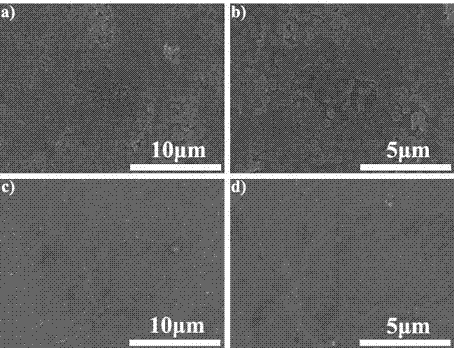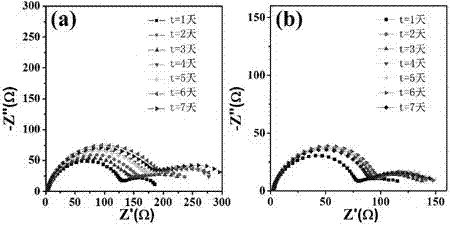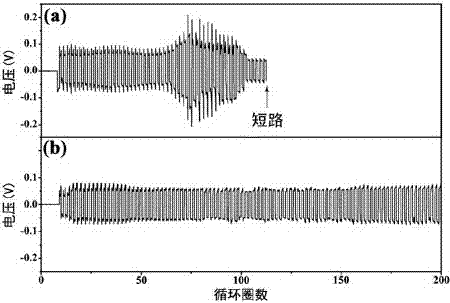Metal lithium negative electrode with organic and inorganic dual protection layers
A double protection, metal lithium technology, applied in the field of electrochemistry, can solve the problems of poor cycle performance, uneven deposition of metal lithium, low coulombic efficiency, etc., achieve high adhesion, facilitate uniform deposition, and improve the effect of Coulombic efficiency
- Summary
- Abstract
- Description
- Claims
- Application Information
AI Technical Summary
Problems solved by technology
Method used
Image
Examples
Embodiment 1
[0028] 0.6 g , 0.39 g of ethyl methacrylate and 10 mg of trihydroxypropionitrile were dissolved in 10 mL of acetone solution, sealed and stirred at room temperature for 6 h to completely dissolve to form a uniform solution. In the glove box, the solution was evenly scraped and coated on the surface of the metal lithium sheet, and the esters were polymerized to form an organic layer under the action of the surface hydroxyl groups, and then dried in the glove box for 10 h to completely remove the acetone, and at the same time, the polymer and trihydroxypropionitrile After contacting with lithium metal, a layer containing Li is formed at the interface 3 N. Li x NO y Inorganic layer, thus forming an organic-inorganic double protective layer on the surface of the metal lithium negative electrode.
[0029] LiFePO 4 as the positive electrode, with LiPF 6 / EC: DMC (1:1) is the electrolyte, and the battery is assembled with unprotected metal lithium and metal lithium with a prote...
Embodiment 2
[0031] 0.8 g , 0.19 g of glycidyl methacrylate and 10 mg of succinonitrile were dissolved in 10 mL of acetone solution, sealed and stirred at room temperature for 6 h to completely dissolve to form a uniform solution. In the glove box, the solution was evenly sprayed on the surface of the metal lithium sheet, polymerized to form a polymer film under the action of the surface hydroxyl groups, and then dried in the glove box for 10 h to completely remove acetone, while the polymer and succinonitrile were mixed with the metal lithium After contact, a layer containing Li is formed at the interface 3 N. Li x NO y Inorganic layer, thus forming an organic-inorganic double protective layer on the surface of the metal lithium negative electrode.
[0032] LiCoO 2 as the positive electrode, with LiPF 6 / EC: DMC (1:1) is the electrolyte, and the battery is assembled with unprotected metal lithium and metal lithium with a protective layer as the negative electrode. The battery perfo...
Embodiment 3
[0034] 0.58 g , 0.4 g methyl methacrylate and 20 mg urea were dissolved in 10 mL acetone solution, sealed and stirred at room temperature for 6 h to completely dissolve and form a uniform solution. In the glove box, the solution was uniformly scraped and coated on the surface of the metal lithium sheet, and polymerized to form a polymer film under the action of the surface hydroxyl group, and then dried in the glove box for 10 h to completely remove the acetone. A Li-containing layer is formed at the interface 3 N. Li x NO y Inorganic layer, thus forming an organic-inorganic double protective layer on the surface of the metal lithium negative electrode.
[0035] A battery was assembled with S as the positive electrode, LiTFSI / DOL:DME (1:1) as the electrolyte, and unprotected metal lithium and metal lithium with a protective layer as the negative electrode. The battery performance is shown in Table 3.
PUM
| Property | Measurement | Unit |
|---|---|---|
| Thickness | aaaaa | aaaaa |
Abstract
Description
Claims
Application Information
 Login to View More
Login to View More - R&D
- Intellectual Property
- Life Sciences
- Materials
- Tech Scout
- Unparalleled Data Quality
- Higher Quality Content
- 60% Fewer Hallucinations
Browse by: Latest US Patents, China's latest patents, Technical Efficacy Thesaurus, Application Domain, Technology Topic, Popular Technical Reports.
© 2025 PatSnap. All rights reserved.Legal|Privacy policy|Modern Slavery Act Transparency Statement|Sitemap|About US| Contact US: help@patsnap.com



